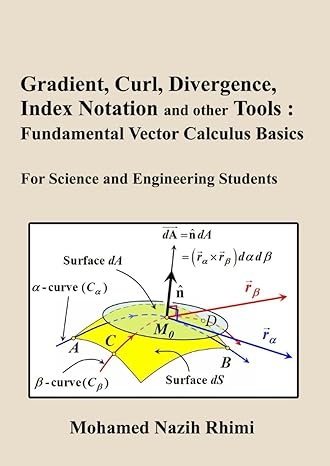Go back


Gradient Curl Divergence Index Notation And Other Tools Fundamental Vector Calculus Basics For Science And Engineering Students(1st Edition)
Authors:
Mohamed Nazih Rhimi

Cover Type:Hardcover
Condition:Used
In Stock
Include with your book
Free shipping: April 13, 2024Popular items with books
Access to 3 Million+ solutions
Free ✝
Ask 10 Questions from expert
200,000+ Expert answers
✝ 7 days-trial
Total Price:
$0
List Price: $40.00
Savings: $40(100%)
Book details
ISBN: 979-8403541473
Book publisher: Independently published
Get your hands on the best-selling book Gradient Curl Divergence Index Notation And Other Tools Fundamental Vector Calculus Basics For Science And Engineering Students 1st Edition for free. Feed your curiosity and let your imagination soar with the best stories coming out to you without hefty price tags. Browse SolutionInn to discover a treasure trove of fiction and non-fiction books where every page leads the reader to an undiscovered world. Start your literary adventure right away and also enjoy free shipping of these complimentary books to your door.
Gradient Curl Divergence Index Notation And Other Tools Fundamental Vector Calculus Basics For Science And Engineering Students 1st Edition Summary: Beginning with preliminary notions of linear algebra and ending with the general theorems of Green, Stokes, and divergence with their modified forms, the text explores the close relationships between the various parametric representations of curves, surfaces and volumes, focusing especially on their applications to the line, surface and volume integrals of vector fields, and establishing the underlying links in a rigorous and comprehensive treatment. The various concepts are analyzed in depth and accompanied by self-explanatory illustrations, examples solved in detail and physical applications. The exercises at the end of each chapter are direct applications of the chapter subjects and an explicit review of what has been covered. This book is designed for a wide range of disciplines including mathematics, physical sciences and engineering. The text is self contained and therefore suitable for individual reading by students, but in order to progress, it is essential to pay attention and not skip any paragraphs or remarks.Just before publishing the present book, I unintentionally recalled the anguish and frustration I felt when I started to manipulate all these mathematical tools during my first contact with the university. And especially that famous Nabla operator that I used to find everywhere stuck to divergence, curl, laplacian, index notation and general theorems of vector calculus. I will not blame my teachers for their spontaneous shortcomings as much as I blame any defective educational system that under-estimates the real value of such notions as a solid foundation for any scientific or engineering student.Taking my first courses in mechanics and electricity at the university a long time ago, this gradient bothered me a lot and broke my nerves with those weird coordinate systems and partial derivatives that have left a bad taste in my mouth until now. It was only late in my math courses that I started to swallow these things. It is in this spirit that I wrote this book in order to simplify to students what was inaccessible to me and to save them a trouble that does not deserve. This book is a unique piece of work, not for what it contains, because what it contains can be found in other books, but for the spirit, the methodology, the style and the way it was written. I have tried my best to make it a very sequential and uncluttered book, simple in style and containing everything the reader needs without being a mathematics genius or a physics giant.All the reader needs is a sincere determination to defy the difficulties of vector analysis and a real readiness to put in a little effort and time, to pick up a pen and paper and to go through the book step by step, from the beginning till the end. I can imagine the reader's enjoyment, regardless of his academic background, as he follows the text and re-reads what he did not understand, solving the examples and trying with the exercises. I can only promise the reader that after finishing the last page, he or she will not need to look for other books that explain what I have explained in this book of mathematical tools for science and engineering students.This book progresses slowly but surely, consolidating the foundations as it goes along and leading the students step by step, with lucidity, ease and absolute rigor, to use vector calculus and to acquire this magnificent tool that is the index notation and to master this universal language common to scientists whatever their disciplines.
Customers also bought these books
Frequently Bought Together
Top Reviews for Books
Ulysses Glen
( 4 )
"Delivery was considerably fast, and the book I received was in a good condition."










